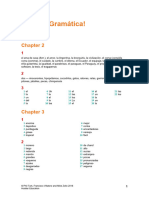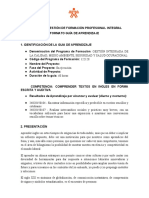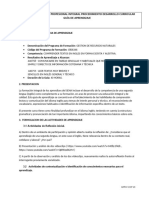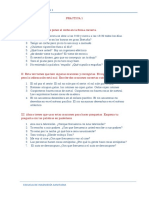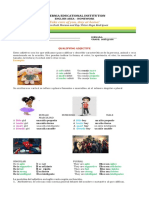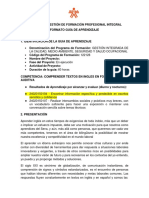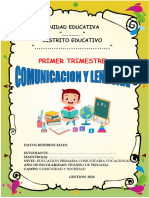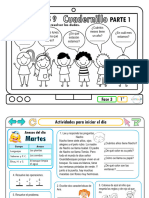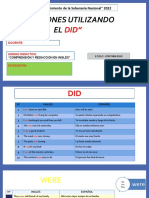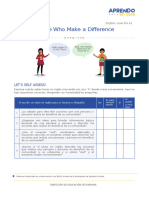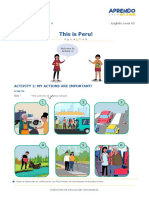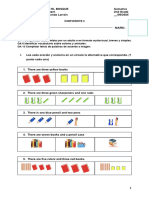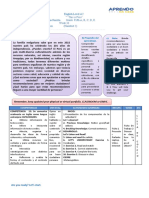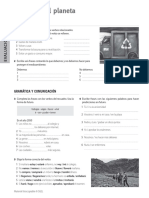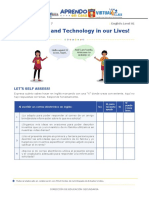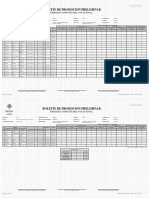Actividad # 5 PDF
Actividad # 5 PDF
Cargado por
Bibiana Torres ArangoCopyright:
Formatos disponibles
Actividad # 5 PDF
Actividad # 5 PDF
Cargado por
Bibiana Torres ArangoTítulo original
Derechos de autor
Formatos disponibles
Compartir este documento
Compartir o incrustar documentos
¿Le pareció útil este documento?
¿Este contenido es inapropiado?
Copyright:
Formatos disponibles
Actividad # 5 PDF
Actividad # 5 PDF
Cargado por
Bibiana Torres ArangoCopyright:
Formatos disponibles
Full name OLGA BIBIANA TORRES ARANGO
Date 10/10/2020
City CAMPAMENTO
TECNOLOGO EN GESTIÓN DE LA ID 2104024
Programme
SST
Instructor FERNEY ALEXANDER HERRERA MADERA
Vocabulary Builder 1
Unit 3 - Audio 1
» Ejercicio Escribe la traducción de las oraciones de la columna de la izquierda en los
campos en blanco de la columna de la derecha:
1 Canada is a big country. Canada es un gran pais
2 Singapore is a small country. Singapur es un pais pequeño
3 Paris is a beautiful city. Paris es una ciudad Hermosa
4 Paris is not an ugly city. Paris no es una ciudad fea
5 The Sahara is very hot. El Sahara es muy caliente
6 Antarctica is very cold. La Antártida es muy frío
7 The Amazon is a long river. El Amazonas es un río largo
8 The Amazon is not a short river. El Amazonas no es un río corto
9 I am in New York; Philadelphia is near. Estoy en New York, Filadelfia está cerca
10 I am in New York; Beijing is far. Estoy en New York, Beijing está lejos
11 Mr. Archer is a man; he is tall. El señor Archer es un hombre. Él está alto
12 Billy is a boy; he is short. Billy es un chico. Él es bajo
13 Billy’s grandfather is old. Billy es Abuelo, él es viejo
14 Billy is not old; he’s young. Billy no es Viejo, é les joven
Mi profesora es excelente, ella es muy
15 My professor is excellent; she is very good.
Buena
16 Your professor is not good; he’s bad. Tu professor no es Bueno, é les malo
17 1+1 is easy! 1 + 1 es fácil
Servicio Nacional de Aprendizaje – SENA CTGI 2020 2
Unit 3: Big or Small? Short or Tall? | Texts based on the Living Language methodology. (1 ST term)
18 2x(3y-4x)=2y/x is hard! 2x(3y-4x)= 2y/x is dificil
Servicio Nacional de Aprendizaje – SENA CTGI 2020 3
Unit 3: Big or Small? Short or Tall? | Texts based on the Living Language methodology. (1 ST term)
Vocabulary Practice 1
» Ejercicio Practiquemos el vocabulario que has aprendido. Completa las oraciones
escribiendo la palabra correspondiente en el campo en blanco:
1 China is not a small country; it’s a Big country.
2 The Amazon is not a short river; it’s a long river.
3 My grandparents are not young; they are old .
4 Antarctica is very cold .
5 Saudi Arabia is not cold; it’s hot .
6 You’re in Philadelphia, so New York is near .
7 You’re in Philadelphia, so Tokyo is far .
8 My professor is not bad; he’s very good .
9 The woman is not short ; she’s tall.
10 San Francisco is not an ugly city; it’s a beautiful city.
11 What’s one plus one? That’s an easy question.
12 But the professor’s question isn’t easy; it’s hard .
Servicio Nacional de Aprendizaje – SENA CTGI 2020 4
Unit 3: Big or Small? Short or Tall? | Texts based on the Living Language methodology. (1 ST term)
Take it further
Unit 3 - Audio 2
» Ejercicio 1 Colours son adjetivos útiles. Traduce las siguientes oraciones:
1 The sky at night is black. El cielo en la noche es negro
2 Snow is white. La nieve es blanca
3 Roses are red. Las rosas son rojas
4 The ocean is blue. El océano es azul
5 Plants are green. Las Plantas son verdes
6 Bananas are yellow. Las bananas son amarillas
7 Tea is brown. El té es café
8 Oranges are orange. Las naranjas son naranjas
9 Grapes are purple. Las uvas son púrpuras
10 Elephants are grey. Los elefantes son grises
» Ejercicio 2 Miremos algunos ejemplos. Traduce las siguientes oraciones:
The American flag is red, white and
1 La bandera America es roja, blanca y azul
blue.
2 The Chinese flag is red and yellow. La bandera de China es Roja y amarilla
The Indian flag is orange, green, La bandera de India es Naranja, Verde,
3
white and blue. blanca y azul
At night, the sky is black, but En la noches el cielo es negro, pero
4
during the day, the sky is blue. durante el día el cielo es azul
Servicio Nacional de Aprendizaje – SENA CTGI 2020 5
Unit 3: Big or Small? Short or Tall? | Texts based on the Living Language methodology. (1 ST term)
Grammar Builder 1
Unit 3 - Audio 3
» Para realizar una pregunta con am, is, o are, mueve el verbo al frente:
Yes o No?
AFFIRMATION INTERROGATION
I am… Am I…?
You are a professor. Are you a professor?
He is Chinese. Is he Chinese?
Martine is French. Is Martine French?
We are at the university. Are we at the university?
The children are young. Are the children young?
» Para responder una pregunta be (ser o estar), usa yes o no + not:
Is New York a beautiful city?
1 Yes, New York is a beautiful city.
No, New York is not a beautiful city.
Is he a good professor?
2 Yes, he is a good professor.
No, he is not a good professor.
Is Chicago far?
3 Yes, Chicago is far.
No, Chicago is not far.
Servicio Nacional de Aprendizaje – SENA CTGI 2020 6
Unit 3: Big or Small? Short or Tall? | Texts based on the Living Language methodology. (1 ST term)
» Para realizar una pregunta con have, utiliza do… have…?:
AFFIRMATION INTERROGATION
I have… Do I have…?
You have a sister. Do you have a sister?
They have children. Do they have children?
» Para realizar una pregunta con has, utiliza does… have…? :
AFFIRMATION INTERROGATION
He has… Does he have…?
She has… Does she have…?
Jenny has a brother. Does Jenny have a brother?
Billy has a sister. Does Billy have a sister?
Servicio Nacional de Aprendizaje – SENA CTGI 2020 7
Unit 3: Big or Small? Short or Tall? | Texts based on the Living Language methodology. (1 ST term)
» Para responder una pregunta have, utiliza yes o no + do not have:
Do they have children?
1 Yes, they have children.
No, they do not have children.
Do we have a good professor?
2 Yes, we have a good professor.
No, we do not have a good professor.
» Para responder una pregunta has, utiliza yes o no + does not have:
Does Bob have a wife?
1 Yes, he has a wife.
No, he does not have a wife.
Does Mrs. Archer have children?
2 Yes, she has children.
No, she does not have children.
Servicio Nacional de Aprendizaje – SENA CTGI 2020 8
Unit 3: Big or Small? Short or Tall? | Texts based on the Living Language methodology. (1 ST term)
Take it further
Unit 3 - Audio 4
» En Unit 1 aprendiste las formas largas del verbo to be (I am, you are, he is, we are,
they are) y las formas cortas (I’m, you’re, he’s, she’s, we’re, they’re). Las formas cortas
son contracciones. También hay contracciones con not. Miremos primero las del
verbo to be:
INTERROGATION NEGATION
Am I a professor? No, I’m not a professor.
No, you’re not a student.
Are you a student?
No, you aren’t a student.
No, he’s not a student.
Is he a student?
No, he isn’t a student.
No, we’re not in Boston.
Are we in Boston?
No, we aren’t in Boston.
No, They’re not near.
Are they near?
No, they aren’t near.
Servicio Nacional de Aprendizaje – SENA CTGI 2020 9
Unit 3: Big or Small? Short or Tall? | Texts based on the Living Language methodology. (1 ST term)
» Con I, hay una contracción (I’m not). Pero con you, he, she, it, we, y they, hay dos:
pronombre + be (I’m, you’re, etc.) y be + not (aren’t, isn’t, etc.):
PRONOUN + BE BE + NOT
I’m not -----
You’re not You aren’t
He’s not He isn’t
She’s not She isn’t
It’s not It isn’t
We’re not We aren’t
They’re not They aren’t
» Con have, solo están las contracciones do/does + not:
INTERROGATIONS NEGATIONS
Do I have children? No, I don’t have children.
Do you have a son? No, You don’t have a son.
Does he have a good professor? No, he doesn’t have a good professor.
Does she have a brother? No, she doesn’t have a brother.
Do we have cousins? No, we don’t have cousins.
Do they have a daughter? No, they don’t have a daughter.
Servicio Nacional de Aprendizaje – SENA CTGI 2020 10
Unit 3: Big or Small? Short or Tall? | Texts based on the Living Language methodology. (1 ST term)
Vocabulary Builder 2
Unit 3 - Audio 5
» Ejercicio Escribe la traducción de las oraciones de la izquierda en los cuadros en los
campos en blanco de la derecha:
There is a good university in the
1 Hay una buena Universidad en la ciudad
city.
There are two good universities in
2 Hay dos buenas universidades en la ciudad
the city.
There is an excellent professor at Hay un excelente professor en la
3
the university. Universidad
There are excellent professors at Hay excelentes profesores en la
4
the university. universidades
5 There is a young girl in the family. Hay una chica joven en la familia
There are three young girls in the
6 Hay tres chicas jóvenes en la familia
family.
There are tall buildings in New
7 Hay edificios altos en New York
York.
There are long rivers in South
8 Hay rios largos en America del Sur
America.
There is excellent wine from
9 Hay un vino excelente de Francia
France.
There are beautiful cities in
10 Hay ciudades hermosas en Europa.
Europe.
Servicio Nacional de Aprendizaje – SENA CTGI 2020 11
Unit 3: Big or Small? Short or Tall? | Texts based on the Living Language methodology. (1 ST term)
Vocabulary Practice 2
Unit 3 - Audio 6
» Ejercicio Escucha nuevamente y escribe las palabras que oigas:
1 there is a good university in the city.
2 There are two good universities in the city.
3 There is an excellent professor at the university.
4 There are excellent professors at the university.
5 There is a young girl in the family.
6 There are three young girls in the family.
7 There are tall buildings in New York.
8 There are long rivers in South America.
9 There is excellent wine from France.
10 There are beautiful cities in Europe.
Servicio Nacional de Aprendizaje – SENA CTGI 2020 12
Unit 3: Big or Small? Short or Tall? | Texts based on the Living Language methodology. (1 ST term)
Grammar Builder 2
Unit 3 - Audio 7
Numbers and plurals
» Revisemos los números en inglés:
NUMBERS NUMERALS
One, two, three 1, 2, 3
Four, five, six 4, 5, 6
Seven, eight 7, 8
Nine, ten 9, 10
» La mayoría de los números desde el 13 hasta el 19 finalizan en -teen:
NUMBERS NUMERALS
Eleven, twelve, thirteen 11, 12, 13
Fourteen, fifteen, sixteen 14, 15, 16
Seventeen, eighteen, nineteen 17, 18, 19
Servicio Nacional de Aprendizaje – SENA CTGI 2020 13
Unit 3: Big or Small? Short or Tall? | Texts based on the Living Language methodology. (1 ST term)
» Los múltiplos de 10 desde el 20 hasta el 90 finalizan en -ty:
NUMBERS NUMERALS
Twenty, thirty, forty 20, 30, 40
Fifty, sixty, seventy 50, 60, 70
Eighty, ninty, one hundred 80, 90, 100
» Para decir 21, 32, 43, y demás, solo pon los dos números juntos separados por un guion
(-):
NUMBERS NUMERALS
Twenty-one, twenty-two, twenty-three 21, 22, 23
Thirty-four, thirty-five-thirty-six 34, 35, 36
Forty-seven, fifty-eight, ninety-nine 47, 58, 99
» Para indicar la edad, usa una forma del to be y un número, o to be + years old. La
pregunta es How old is/are…?
QUESTION ANSWER
How old is Billy? He’s ten years old.
How old is Jenny? She’s fourteen.
How old is Billy and Jenny’s
She’s sixty-three.
grandmother?
They are ten and fourteen
How old are Billy and Jenny?
years old.
Servicio Nacional de Aprendizaje – SENA CTGI 2020 14
Unit 3: Big or Small? Short or Tall? | Texts based on the Living Language methodology. (1 ST term)
» Con one, usa el singular. Con dos o más, usa el plural. La mayoría de sustantivos
adicionan –s en el plural:
SINGULAR PLURAL
One boy Two boys, three boys
One student Ten students, fifteen students
Five professors, twenty
One professor
professors
» Si un sustantivo termina en –y, el plural finaliza en -ies:
SINGULAR PLURAL
One university Two universities
One country Three countries
One city Four cities
» Algunos sustantivos tienen plurales irregulares:
SINGULAR PLURAL
One man Two men
One woman Three women
One child Four children
One person Ten people
Servicio Nacional de Aprendizaje – SENA CTGI 2020 15
Unit 3: Big or Small? Short or Tall? | Texts based on the Living Language methodology. (1 ST term)
» Con el singular, emplea there is (there’s). Con el plural, emplea there are:
SINGULAR PLURAL
There is… There are…
There are three good
There is a good university in the city.
universities in the city.
There is a very good student in the There are very good students in
class. the class.
There are three boys in the
There is one boy in the family.
family.
Servicio Nacional de Aprendizaje – SENA CTGI 2020 16
Unit 3: Big or Small? Short or Tall? | Texts based on the Living Language methodology. (1 ST term)
Work Out 1
Unit 3 - Audio 8
» Ejercicio Escucha y escribe las palabras que oigas:
1 Billy is a young boy. He is ten years old.
a big family, he
2 He Doesn´t small family.
has a
3 They´re four people in his family.
4 Billy’s father’s name is Paul.
5 his mother's name is Laura.
have a brother, but
6 Billy Doesn´t has a sister.
he
7 His sister name is Jenny.
8 Jenny is fourteen .
9 Billy and Jenny have a cousin.
His name is Max, and he is Nine years old .
Servicio Nacional de Aprendizaje – SENA CTGI 2020 17
Unit 3: Big or Small? Short or Tall? | Texts based on the Living Language methodology. (1 ST term)
Bring It All Together
Unit 3 - Audio 9
» Ejercicio Con el apoyo de otro compañero de clase van a realizar la escucha del
siguiente diálogo. Una vez finalicen, procederán a generar una grabación del mismo
diálogo, pero ahora con sus voces.
El audio deberán iniciarlo presentándose, indicando sus nombres, edad y lugares de
procedencia.
Example
Person 1: Good morning, my name is Florentino Ariza, I’m 27 years old, I’m from Ituango,
Antioquia.
Person 2: Hello, my name is Fermina Daza, I’m 18 years old, I’m from Yarumal, Antioquia.
Cuando esté el audio grabarlo, enviarlo como evidencia de trabajo por el apartado
correspondiente de plataforma acompañado del resto de ejercicios de esta actividad.
Servicio Nacional de Aprendizaje – SENA CTGI 2020 18
Unit 3: Big or Small? Short or Tall? | Texts based on the Living Language methodology. (1 ST term)
» Conociste a John en Unit 1. John es un estudiante de universidad. Él tiene una clase
llamada American Literature of the Twentieth Century. Pero John NO es un muy buen
estudiante. Escucha lo que él habla con su amiga Diane:
1 Diane Are you in Professor Wheaton’s class?
2 John Yes, I am. It’s American Literature of the Twentieth Century.
3 Diane Is it a good class?
4 John Yes, it’s very good, but it’s hard!
5 Diane Is Professor Wheaton a good professor?
6 John Yes, she’s very smart, but her questions are hard! And the books are hard!
7 Diane How many students are there in the class?
8 John There are twenty-three students in the class.
9 Diane Are there good students in the class?
10 John Yes, there are three or four excellent students in the class.
11 Diane Are you an excellent student?
12 John No, I’m not an excellent student.
13 Diane Well, are you a good student?
14 John No, I’m not a good student. I’m an okay student.
15 Diane An okay student? Do you have homework tonight?
16 John Yes, I have homework, but there’s a party tonight, and…
17 Diane John! You have homework tonight!
18 John Yes, I do. But there’s a party, and…
19 Diane And you’re not an excellent student.
Servicio Nacional de Aprendizaje – SENA CTGI 2020 19
Unit 3: Big or Small? Short or Tall? | Texts based on the Living Language methodology. (1 ST term)
Take it further
Unit 3 - Audio 10
» Aprendiste sobre preguntas tipo yes/no en esta unidad. Otras preguntas tienen question
words (palabras interrogativas). En unidades 1, 2 y 3 has visto:
QUESTION WORDS EXAMPLES
» What’s your name?
What?
» My name is John.
» Who is this man?
Who?
» He’s my father.
» How are you?
» I’m fine, thanks.
How?
» How old is Billy?
» He’s ten years old.
» How many students are
there in the class?
How many?
» There are twenty-three
students in the class.
Servicio Nacional de Aprendizaje – SENA CTGI 2020 20
Unit 3: Big or Small? Short or Tall? | Texts based on the Living Language methodology. (1 ST term)
Work Out 2
» Ejercicio 1 Elige there is o there are:
1 There is very good wine from France.
2 There are fifty states in the United States.
3 There are tall buildings in New York
4 There is an excellent student in the class.
5 There are twenty-three students in the class.
6 There are two girls in the family.
7 There is a very long river in Brazil.
8 There are three children in the family.
» Ejercicio 2 Elige la palabra correcta:
1 You have three sisters.
2 Does she have a brother?
3 Yes, she has a brother.
4 No, she doesn't have a brother.
5 The man have a wife.
6 The man doesn’t have a wife.
7 I don't have a sister.
8 We don’t have a big family.
Servicio Nacional de Aprendizaje – SENA CTGI 2020 21
Unit 3: Big or Small? Short or Tall? | Texts based on the Living Language methodology. (1 ST term)
» Ejercicio 3 Ahora, forma algunas preguntas. Por ejemplo, tendrás:
She has a sister. Y deberás escribir: Does she have a sister?:
He is tall.
1
Is he tall?
The girls have a brother.
2
Do girls have a brother?
The family is big.
3
Is the family big?
The professors are very good.
4
Are the professors very good?
The students have an easy class.
5
Do the students have an easy class?
The boy has a sister.
6
Does the boy has a sister?
The river is long.
7
Is long the river?
Canada and China are big countries.
8
Are Canada and China big countries?
Servicio Nacional de Aprendizaje – SENA CTGI 2020 22
Unit 3: Big or Small? Short or Tall? | Texts based on the Living Language methodology. (1 ST term)
Drive It Home
» Ejercicio 1 Practiquemos preguntas y respuestas. Primero, con be. Crea oraciones de
respuestas afirmativas y negativas siguiendo el ejemplo:
Example
Question Is New York a beautiful city?
0 YES Yes, New York is a beautiful city.
NO No, New York is not a beautiful city.
Question Is it a big country?
1 YES Yes, it is a big country
NO No, it is a not big country
Question Is the professor good?
2 YES Yes, she is professor good
NO No, she is not professor good
Question Are the questions easy?
3 YES Yes, they are the question easy
NO No, they are not the question easy
Question Are the children very young?
4 YES Yes, they are children very young
NO No, they are not children very young
Servicio Nacional de Aprendizaje – SENA CTGI 2020 23
Unit 3: Big or Small? Short or Tall? | Texts based on the Living Language methodology. (1 ST term)
» Ejercicio 2 Ahora practiquemos preguntas y respuestas con have. Crea oraciones de
respuestas afirmativas y negativas siguiendo el ejemplo:
Example
Question Do we have a good professor?
0 YES Yes, we have a good professor.
NO No, we don’t have a good professor.
Question Does she have a brother?
1 YES Yes, she has a brother
NO No, she does has not a brother
Question Do they have children?
2 YES Yes, they have children
NO No, they do have not children
Question Does she have a husband?
3 YES Yes, she has a husband
NO No, she does has not
Question Do the boys have a sister?
4 YES Yes, they have a sister
NO No, they do have not a sister
Servicio Nacional de Aprendizaje – SENA CTGI 2020 24
Unit 3: Big or Small? Short or Tall? | Texts based on the Living Language methodology. (1 ST term)
Online exercises
https://www.livinglanguage.com/languagelab/eslenglish/4394/essential-
big-or-small-short-or-tall/adjective-practice
» Ejercicio Haz clic sobre el enlace, juega con palabras y frases relacionadas con
Unit 3 | Big or Small? Tall or Short? y, finalmente, agrega algunas capturas de pantalla:
Example
Servicio Nacional de Aprendizaje – SENA CTGI 2020 25
Unit 3: Big or Small? Short or Tall? | Texts based on the Living Language methodology. (1 ST term)
Servicio Nacional de Aprendizaje – SENA CTGI 2020 26
Unit 3: Big or Small? Short or Tall? | Texts based on the Living Language methodology. (1 ST term)
Servicio Nacional de Aprendizaje – SENA CTGI 2020 27
Unit 3: Big or Small? Short or Tall? | Texts based on the Living Language methodology. (1 ST term)
También podría gustarte
- Accion Gramatica ANSWERSDocumento50 páginasAccion Gramatica ANSWERSjdjdAún no hay calificaciones
- Ensayo-Texto Argumentativo - Estructura - Ingreso LibreDocumento2 páginasEnsayo-Texto Argumentativo - Estructura - Ingreso LibreCARLOS DANIEL HUACANJULCA AYAYAún no hay calificaciones
- Translation - Booklet - 1Documento64 páginasTranslation - Booklet - 1Javier P G100% (1)
- Control Canal MirafloresDocumento12 páginasControl Canal MirafloresRONY ACOSTAAún no hay calificaciones
- Evaluación de Unidad 1 - 5º - Básico - LenguajeDocumento7 páginasEvaluación de Unidad 1 - 5º - Básico - LenguajeElizabeth RebolledoAún no hay calificaciones
- 4TO - EXP 9 ACT. 2-INGLÉS ResueltoDocumento3 páginas4TO - EXP 9 ACT. 2-INGLÉS ResueltoLEONARDITO RIQUELME ARAUJO VALENCIAAún no hay calificaciones
- GFPI-F-135 - Guia - de - Aprendizaje 3. Integrated Management SystemsDocumento25 páginasGFPI-F-135 - Guia - de - Aprendizaje 3. Integrated Management Systemsnícol fajardoAún no hay calificaciones
- Actividad 3Documento8 páginasActividad 3Dayana Rico100% (1)
- GuiadeaprendizajeBil1 165f5a48cfbfeccDocumento9 páginasGuiadeaprendizajeBil1 165f5a48cfbfeccJoshJimenezAún no hay calificaciones
- Guia de Aprendizaje - Nivel 2Documento18 páginasGuia de Aprendizaje - Nivel 2Marilyn Rodriguez OrtizAún no hay calificaciones
- BedoyaConrado 2010 InglesIngenierosWorbookDocumento92 páginasBedoyaConrado 2010 InglesIngenierosWorbookOLGA CONSTANZA PABON PUENTEAún no hay calificaciones
- Guia de Aprendizaje Ib 1.1Documento22 páginasGuia de Aprendizaje Ib 1.1YEIMY PADILLAAún no hay calificaciones
- Activity 10 Dayana RicoDocumento9 páginasActivity 10 Dayana RicoEusebio DiazAún no hay calificaciones
- Taller # 3Documento5 páginasTaller # 3Karlizz Oviedo VelasquezAún no hay calificaciones
- Oraciones Con El Verbo Tobe en Presente y en Pasado SimpleDocumento10 páginasOraciones Con El Verbo Tobe en Presente y en Pasado Simpleoswaldo borgesAún no hay calificaciones
- 3º Week 36 Exp - Aprend.9-S-01Documento6 páginas3º Week 36 Exp - Aprend.9-S-01nico FCAún no hay calificaciones
- Guia RESUELTADocumento10 páginasGuia RESUELTAingrid rubioAún no hay calificaciones
- English Learning Guide # 5 SEXTO - SÉPTIMO Septiembre 03Documento10 páginasEnglish Learning Guide # 5 SEXTO - SÉPTIMO Septiembre 03LUIS ANGEL ESCALNTEAún no hay calificaciones
- GUIA DE DIGNOSTICO A1.2 InglesDocumento4 páginasGUIA DE DIGNOSTICO A1.2 InglesjhosuaAún no hay calificaciones
- bec2d029-089a-40a6-b1f0-c37098d7a817Documento7 páginasbec2d029-089a-40a6-b1f0-c37098d7a817Thomás Flórez QuinteroAún no hay calificaciones
- ENGLISHDocumento5 páginasENGLISHgersonAún no hay calificaciones
- Tarea de InglésDocumento9 páginasTarea de InglésMargarita Beltran ArceAún no hay calificaciones
- Taller1-VerbToBe - Numbers, Possessives, Demostratives, FamilyDocumento25 páginasTaller1-VerbToBe - Numbers, Possessives, Demostratives, FamilyMaria Fernanda Calderon0% (1)
- Traduccion Ingles 1Documento32 páginasTraduccion Ingles 1Leonel BerriosAún no hay calificaciones
- Trabajo de Ingles Guia 1Documento8 páginasTrabajo de Ingles Guia 1Leidy mayury Samaca MoralesAún no hay calificaciones
- WEEK 34 HANDOUT 1 My Actions Are ImportantDocumento4 páginasWEEK 34 HANDOUT 1 My Actions Are ImportantBrayan AdamsAún no hay calificaciones
- Los Adjetivos en InglésDocumento4 páginasLos Adjetivos en InglésMaria100% (1)
- Do It Yorself!Documento6 páginasDo It Yorself!Angelica TantajulcaAún no hay calificaciones
- 5TH GRADE INGLES CARPETA DE RECUPERACION Word OkDocumento22 páginas5TH GRADE INGLES CARPETA DE RECUPERACION Word OkCarmen Alva NamocAún no hay calificaciones
- Qualifying Adjectives Activity #5 Second Term.....Documento5 páginasQualifying Adjectives Activity #5 Second Term.....KELY MABEL GUERRERO LAZOAún no hay calificaciones
- Guia de Ingles PDFDocumento19 páginasGuia de Ingles PDFPaula MedinaAún no hay calificaciones
- 1 - Comunicación 4TO - I - TRIMDocumento50 páginas1 - Comunicación 4TO - I - TRIMkeitonbebe1095Aún no hay calificaciones
- Self-Study Guide - #7 TASK 2Documento7 páginasSelf-Study Guide - #7 TASK 2Idalith Abondano RodriguezAún no hay calificaciones
- Adecuación LE 09-A1-Activity 1 Evelin Paredes BaconDocumento3 páginasAdecuación LE 09-A1-Activity 1 Evelin Paredes Baconesteysi floresAún no hay calificaciones
- Adjetivos en InglesDocumento3 páginasAdjetivos en InglesdaniAún no hay calificaciones
- Taller1 - Verb To Be in PastDocumento10 páginasTaller1 - Verb To Be in PastDayanna MorenoAún no hay calificaciones
- People Who Make A Difference: Competencia Capacidades Propósito DesempeñoDocumento6 páginasPeople Who Make A Difference: Competencia Capacidades Propósito DesempeñoLEONEL JAIRO CANALES CAMPOSAún no hay calificaciones
- Taller Verbo To BeDocumento7 páginasTaller Verbo To BeClaudia Ustaris NavarroAún no hay calificaciones
- Cuadernillo 1°Documento17 páginasCuadernillo 1°Kenia Plata100% (1)
- GFPI-F-135 - Guia - de - Aprendizaje 3. Environmental ControlDocumento22 páginasGFPI-F-135 - Guia - de - Aprendizaje 3. Environmental Controlhamilton belloAún no hay calificaciones
- Oraciones en Inglés Was y WereDocumento3 páginasOraciones en Inglés Was y WereVictor Manuel Delgado PulceAún no hay calificaciones
- 1-Taller3 VerbtoBE-Indefinite Article (Reparado)Documento7 páginas1-Taller3 VerbtoBE-Indefinite Article (Reparado)YANIS PAOLA BELTRAN MUÑOZAún no hay calificaciones
- Melendez Experience 4 Activity 1 MineduDocumento5 páginasMelendez Experience 4 Activity 1 MineduBetzabe Ricci VictorioAún no hay calificaciones
- Melendez Experience 4 Activity 1 MineduDocumento5 páginasMelendez Experience 4 Activity 1 MineduBetzabe Ricci VictorioAún no hay calificaciones
- Melendez Experience 4 Activity 1 MineduDocumento5 páginasMelendez Experience 4 Activity 1 MineduBetzabe Ricci VictorioAún no hay calificaciones
- Melendez Experience 4 Activity 1 MineduDocumento5 páginasMelendez Experience 4 Activity 1 MineduBetzabe Ricci VictorioAún no hay calificaciones
- Ingles, Quispe YarlequeDocumento6 páginasIngles, Quispe YarlequeLuis david Fernández QuispeAún no hay calificaciones
- Exp9 Ebr Secundaria 5 Seguimosaprendiendo Ingles Act02myactionsareimportant EditDocumento4 páginasExp9 Ebr Secundaria 5 Seguimosaprendiendo Ingles Act02myactionsareimportant EditRosangela CosioAún no hay calificaciones
- s15 Ingles Recurso A2 RespuestasDocumento3 páginass15 Ingles Recurso A2 RespuestasosmarAún no hay calificaciones
- 2 - Coeficiente 2 - PRIMER SEMESTRE - 2024Documento4 páginas2 - Coeficiente 2 - PRIMER SEMESTRE - 2024Tamara MirandaAún no hay calificaciones
- Guia de Aprendizaje - A 1.1 InglesDocumento26 páginasGuia de Aprendizaje - A 1.1 InglesLeidy paola Arevalo lealAún no hay calificaciones
- Guia de Aprendizaje - Nivel 2Documento15 páginasGuia de Aprendizaje - Nivel 2sandra paezAún no hay calificaciones
- Week 33 HANDOUT 2 HOW TO BE A GOOD CITIZENDocumento3 páginasWeek 33 HANDOUT 2 HOW TO BE A GOOD CITIZENBrayan AdamsAún no hay calificaciones
- Prueba de Salida 1º Grado LecturaDocumento11 páginasPrueba de Salida 1º Grado LecturaCésar Emilio Florián PérezAún no hay calificaciones
- InglesDocumento6 páginasInglesnatalia quirozAún no hay calificaciones
- NComp2 GD - Ev8 - 1686Documento2 páginasNComp2 GD - Ev8 - 1686MagdaAún no hay calificaciones
- Asignacion DosDocumento4 páginasAsignacion DosLeiza Linda PelayoAún no hay calificaciones
- Taller 1 Ingles Cleis 3Documento2 páginasTaller 1 Ingles Cleis 3sebastian rivero marin100% (1)
- Experience 7 - Activity 1Documento5 páginasExperience 7 - Activity 1AVELINO HUARCAYA YAURIAún no hay calificaciones
- 2º Ing. Exp 06 - Actv 02Documento4 páginas2º Ing. Exp 06 - Actv 02Edgard Laura ChayñaAún no hay calificaciones
- Taller Verbo TO BEDocumento7 páginasTaller Verbo TO BEYAndrea GGamboaAún no hay calificaciones
- ¡Mejora tu inglés! #2 Práctica extensa de lectura y traducción para estudiantes de inglés: ¡Mejora tu inglés!, #2De Everand¡Mejora tu inglés! #2 Práctica extensa de lectura y traducción para estudiantes de inglés: ¡Mejora tu inglés!, #2Calificación: 5 de 5 estrellas5/5 (2)
- Ajedrez para PrincipiantesDocumento17 páginasAjedrez para PrincipiantesCesar GueriniAún no hay calificaciones
- Que Es InvercionDocumento3 páginasQue Es InvercionNosdy Zayn OverAún no hay calificaciones
- Casos Aprovechamiento Módulo IIIDocumento12 páginasCasos Aprovechamiento Módulo IIIDavid MoralesAún no hay calificaciones
- Entropia en Canal Sin RuidoDocumento3 páginasEntropia en Canal Sin RuidoEduard Campoverde EncaladaAún no hay calificaciones
- Factores Internos Clave Colchones SpringDocumento1 páginaFactores Internos Clave Colchones Springluis.perilla01Aún no hay calificaciones
- Historia BrutalismoDocumento26 páginasHistoria BrutalismoorlandoAún no hay calificaciones
- Taller Guía No. 1Documento6 páginasTaller Guía No. 1Aleja MoralesAún no hay calificaciones
- Ensayo ElectroforesisDocumento7 páginasEnsayo ElectroforesisIliana Pardo Rojas100% (2)
- Estado Actual de Los Recursos Hídricos en ESA Presentacion SDDocumento19 páginasEstado Actual de Los Recursos Hídricos en ESA Presentacion SDIngridSuncinAún no hay calificaciones
- Exp. 01543-2021-0-3002-JP-FC-02 - Resolución - 12778-2022Documento1 páginaExp. 01543-2021-0-3002-JP-FC-02 - Resolución - 12778-2022Wilson Richard Limache PauroAún no hay calificaciones
- Liquido CefalorraquideoDocumento14 páginasLiquido CefalorraquideoPATRICIA DE LA VEGAAún no hay calificaciones
- Una Planta Trata Un Caudal 4,4 L/s en Su Condición de BajaDocumento3 páginasUna Planta Trata Un Caudal 4,4 L/s en Su Condición de BajaJose MendozaAún no hay calificaciones
- Cuidados HumanizadosDocumento9 páginasCuidados HumanizadosVERONICAAún no hay calificaciones
- c1 Catalogo Bolivia PDF Impresor BajaDocumento240 páginasc1 Catalogo Bolivia PDF Impresor BajaDenis Gonzales VasquezAún no hay calificaciones
- Nutricion Del Adulto MayorDocumento54 páginasNutricion Del Adulto MayorneennyyAún no hay calificaciones
- Preguntas EspadaDocumento3 páginasPreguntas Espadadaniela bautista arenasAún no hay calificaciones
- Tema - 2 EjerciciosDocumento34 páginasTema - 2 EjerciciosYeisson Collazos RamirezAún no hay calificaciones
- Pre LiquidacionDocumento33 páginasPre Liquidacionnelson100% (1)
- Cap2 Lógica ProposicionalDocumento29 páginasCap2 Lógica ProposicionalJohn L. Da Rosa GonçalvesAún no hay calificaciones
- Obras Azud y DesarenadoresDocumento52 páginasObras Azud y DesarenadoresPao BelesacaAún no hay calificaciones
- Carta Clinica GuadalupeDocumento2 páginasCarta Clinica GuadalupelisAún no hay calificaciones
- Cambio Giro Monofasico 6 PuntasDocumento1 páginaCambio Giro Monofasico 6 PuntasDenis alexander DeleonchipínAún no hay calificaciones
- Triage en UrgenciasDocumento24 páginasTriage en UrgenciasTaNu Gutierrez100% (1)
- Carballo 2012Documento17 páginasCarballo 2012Loreto Carmona DuránAún no hay calificaciones
- El Adn El Libro de La VidaDocumento16 páginasEl Adn El Libro de La VidaJoselito GarciaAún no hay calificaciones
- Boletin Centralizador 81230309 12 Primero A 2021Documento2 páginasBoletin Centralizador 81230309 12 Primero A 2021Claudia Evelyn Molina CastroAún no hay calificaciones
- Portafolio Raelja ProyectadoDocumento17 páginasPortafolio Raelja ProyectadoCesar PedrozaAún no hay calificaciones
- Semana 2 Anexos - V Ciclo Experiencia #02Documento34 páginasSemana 2 Anexos - V Ciclo Experiencia #02Juan Saul Correa CapilloAún no hay calificaciones
